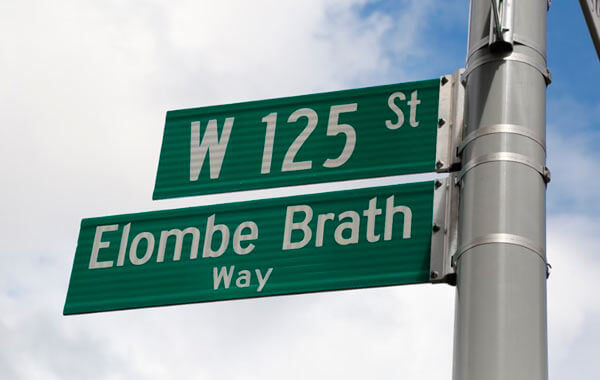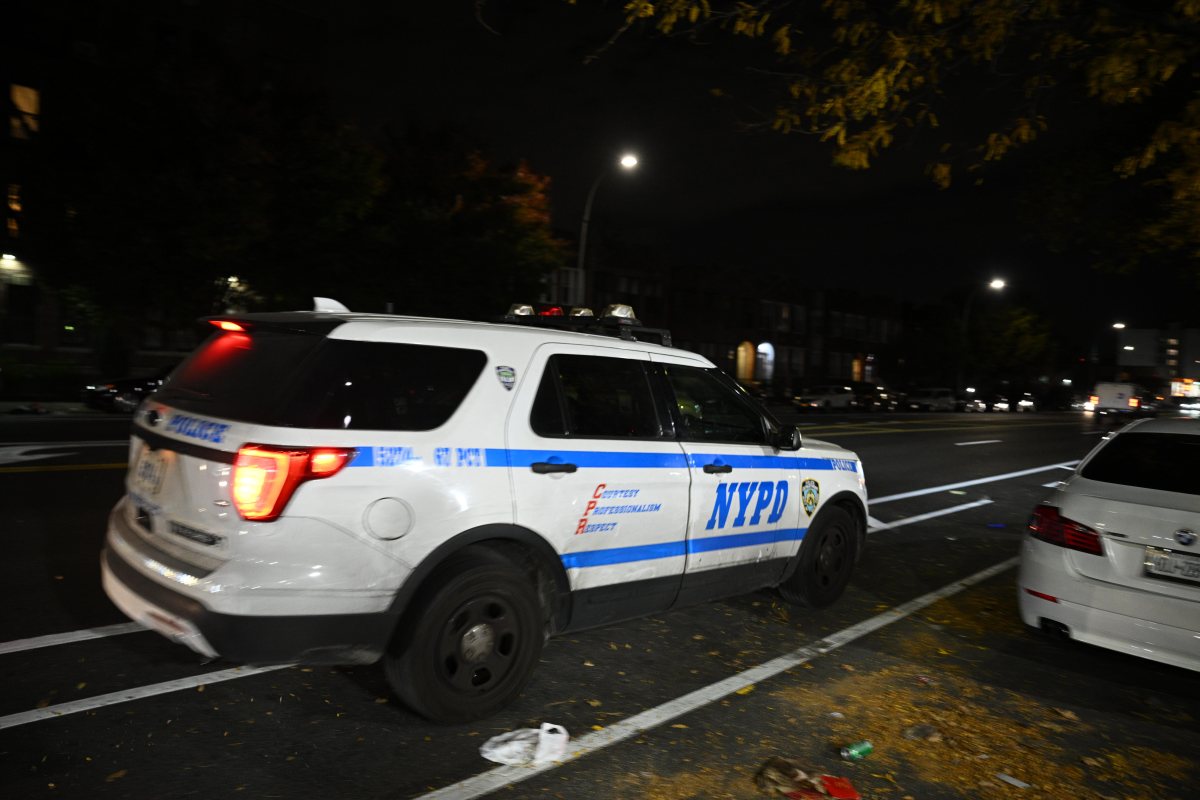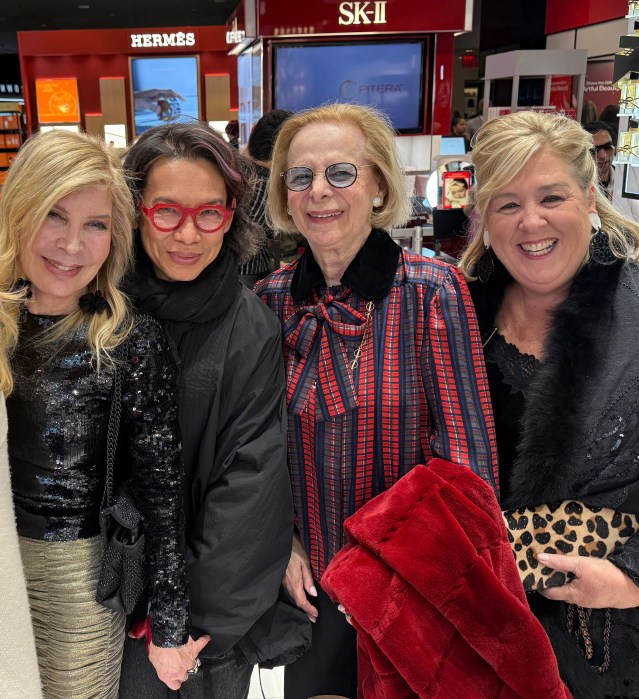The very next time you venture to the southwest corner of 125th St. & Adam Clayton Blvd. in Harlem, look up at the street sign confirming your exact location.
Guaranteed the green and white sign will designate Elombe Brath Way, a co-naming marker New Yorkers recently celebrated with the family of the son of the Brathwaite family from Barbados.
Elombe Brath Way is located at African Plaza one block away from James Brown Way and across from a state office building and statue of the first Black Congressman from New York along a thoroughfare named for the respected and celebrated politician Adam Clayton Powell Jr.
Needless to say, the ceremony was a tribute to a martyr, on the 81st anniversary of his birth and one that united activists, poets, journalists, educators, attorneys, politicians, students, a grateful community, the mayor of New Jersey and a former New York city mayor.
On Sept. 30 as temperatures plunged to the reality of autumn, the first son born to Barbadian nationals was recalled in glowing terms by Newark Mayor Ras Baraka, David N. Dinkins, former New York mayor, City Councilwoman Inez Barron, Councilman Bill Perkins, Assemblyman Charles Barron and a long list of dignitaries.
“He was a giant in African history,” Costa Rica-born Bernardo Rubie said, “his name is highly regarded throughout Africa because he contributed to the liberation of Angola, South Africa and Namibia.”
The owner of Harlem Sesame, a restaurant located one block from the designated signpost, Rubie travelled to Guinea and other Africa states on many occasions with Brath and during a post-reception luncheon briefly related reflections of a 1972 return trip to the capital city of Conakry on the occasion of the funeral of Ghana’s premier leader Kwame Nkruma.
On that occasion he said he marveled after reconciling that at a table he was seated with the Pan-African advocate from Harlem he was also in the company of revolutionaries from Guinea Bissau — Amilcar Cabral, Trinidad & Tobago — Kwame Toure aka Stokely Carmichael and Miriam Makeba from South Africa.
Carmichael dubbed Brath the “dean of Harlem nationalists.”
Dudley Thompson, Jamaica’s ambassador to Nigeria, Senegal, Namibia and Ghana, described Brath as an “icon of the Pan-African Movement.”
And because of his cultural appreciation, first exposed reggae icon Robert “Nesta” Marley to the large New York television population who viewed “Like It Is” the WABC-TV show he worked as a graphic artist from 1962 until his retirement.
Described to be the “remarkable man who lived and worked among and for us,” Brath “became an ancestor three years ago but will forever be in our hearts and minds,” a WBAI-FM Justice & Unity radio campaign press release stated.
For three decades he volunteered time and talent hosting an informative program at the station. “Afrikaleidoscope” informed audiences of the not-for-profit, listener-supported station on news that eluded commercial media outlets.
Shedding light on issues affecting developing countries, Brath delivered enlightenment about the struggle of the Sandanistas in Nicaragua, focused on information related to Costa Rica, Belize and Guatemala and provided breaking and current news about every state in Africa as well as made cultural connections that jazzed up the dial from 99.5 FM.
Prior to that in 1956, along with his brother Kwame, formed the African Jazz-Arts Society & Studios in Harlem to showcase the genre’s African identity. He maintained long-standing relationships with jazz greats Miles Davis, Thelonious Monk, Max Roach, John Coltrane Abby and Lincoln aka Aminata Moseka.
Affectionately known as the “walking encyclopedia,” Brath died May 19, 2014.
Born in Brooklyn, on Sept. 30, 1936 his father Cecil T. Brathwaite and Etelka Margaret Maloney-Brathwaite migrated here in the 1920s. The couple had three sons, Kwame (Ronald) John Edward and Cecil, the eldest who inherited his father’s name but preferred answering to a less colonial moniker that identified him as Elombe Brath.
Influenced by trailblazers such as Marcus Mosiah Garvey, Malcolm X, Carlos A. Cooks, and his cousin Clenell Wickman who allegedly “waged a political battle on behalf of working-class Blacks in colonial Barbados, Brath founded the Patrice Lumumba Coalition.
Named in honor of Patrice Emery Lumumba, the first prime minister of the Democratic Republic of the Congo who was assassinated in 1961, the organization was active throughout the New York area, particularly in Harlem but also on the west coast where a chapter mobilized in Los Angeles, California.
The PLC supported the right to self-determination for Angolans, South Africans, and Namibians and other African liberation movements. As chairman, he organized events and panel discussions dedicated to African politics and current events.
Brath was a fierce advocate for the African National Congress in South Africa, SWAPO in Namibia, MPLA in Angola, FRELIMO in Mozambique and ZANU in Zimbabwe.
Closer to home he fought to eliminate the usage of the term “negro” which was nationally accepted as a definition for Black Americans.
“In 1961, he launched a “Black is Beautiful” campaign with a series of Afrocentric fashion shows featuring African-American women who were known as the Grandassa models and sported large afros,” Wikipedia states.
Nomsa, his wife walked the runway as one of the first Grandassa models.
And although Brath maintained employment as a graphic artist at the corporate commercial media outlet, he conspicuously defied injustice, exploitation and corporate greed.
In 1977, Brath declared solidarity with key members of a coalition that spearheaded a boycott of the South African, Broadway musical, “Ipi Tombe.”
According to reports, the production presented a false image of life for Blacks living in South Africa.
Often in the forefront of conscious protests, the activist / chairman led the PLC in coalescing groups to mobilize mass demonstrations against numerous issues. However, they were prominent at protests against the practice of white rule in Africa.
In 1976, the coalition released a policy memo calling for the support of the Zimbabwe Liberation Army.
For me as a reporter, Brath was a source of inspiration.
On every encounter, he was always loaded down by newspapers. Relentless and persuasive he always offered a leaflet, book or newsletter. My memories of him are indelibly imprinted with recall of our conversations at the opening of the African Burial Ground.
It was he who enlightened me about Zimbabwe’s President Robert Mugabe. And by the time I visited the southern African former British colony it was as if his information was doctrine.
Most will remember Brath’s involvement with the anti-slavery movement in Sudan and Mauritania. His perception of Jomo Kenyatta and his Mau Mau movement in Kenya, Samora Machel of Mozambique, Burkino Faso’s military leader Thomas Sankara, Cuba’s Fidel Castro and ANC’s apartheid ender Nelson Mandela.
Whenever Castro visited New York, there in the midst always was Brath, up close and personal. And I will never forget standing in the middle of 125th St. and 7th Ave when Brath whispered in the ear of the most prominent, female freedom fighter, Winnie Mandela. It was 1990 and she accompanied her husband who had just been released from prison after being confined for more than a quarter of a century.
Midway the private gesture, the regal-looking, revered African gasped, seemingly in disbelief.
I witnessed her reaction and it resonated how she immediately rushed over to greet Dr. Betty Shabazz, the widow of Malcolm X.
She seemed humbled by the presence of a woman she undoubtedly admired. Sister to sister united by a brother who respected them both.
I was privileged to see that it was Brath who informed the first lady of South Africa that she was in the presence of the first lady of Black America.
Brath told me he went to school with Colin Powell.
He gave me valuable insight into the man who retired from military service as a four-star general in the United States Army.
I will always remember Brath walking side-by-side with Sonny Carson, another progressive, conscientious activist who left a hefty legacy to reflect and laud.
And although now it seems as if so many are claiming alliances with advocating for the Central Park Five, back in 1989, it was Brath who stepped out boldly against Donald Trump who placed a full page denouncement of the youths in every major newspaper.
Brath knew the maligned boys personally. They were his neighbors who lived in the same Schomburg Plaza he resided and vouched their innocence. Convinced the teenagers were coerced by members of the NYPD to confess to a crime they did not commit Brath firmly stood his ground in supporting the boys who were convicted and sentenced to serve their youth in prison.
Brath shouted their innocence and unfortunate plight and urged folks to pack the courtroom throughout the trial.
In prison they aged from boys to men and it was there they were proven innocent with Brath ultimately vindicated.
There isn’t enough space allotted for me to acknowledge his deeds.
That he accomplished much with poet Amiri Baraka; received more than 200 awards and recognitions for his activism and dedication or that he was enshrined with a Congressional Record by the 112th Congress four years ago are merely footnotes to his extensive epitaph.
Know that he was a mentor and a dear friend.
The Elombe Brath Foundation established a scholarship fund in his honor which aims to focus on research, education and maintaining international connections, “so our pride and situation won’t be so localized,” Cinque Brath, his youngest son said.
Catch You On The Inside!





















